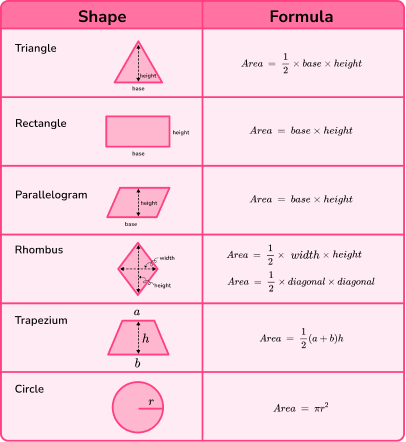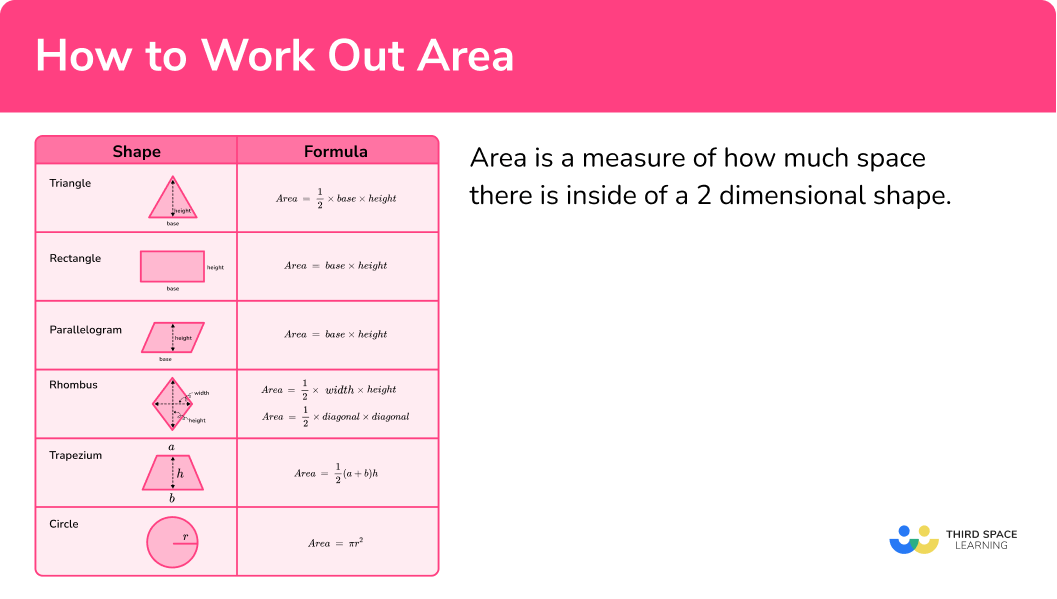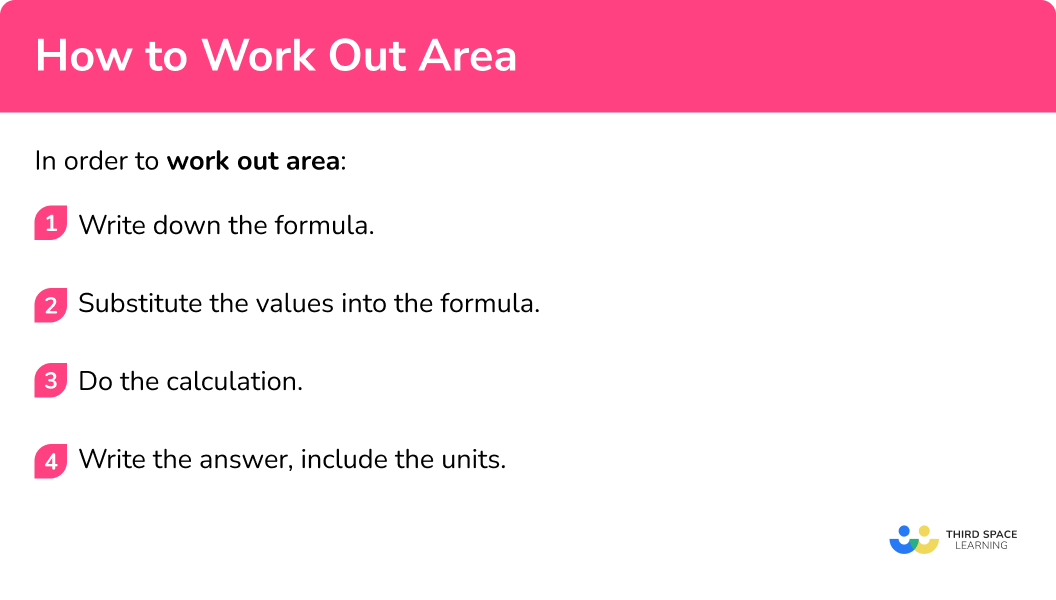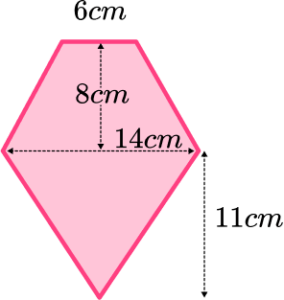One to one maths interventions built for KS4 success
Weekly online one to one GCSE maths revision lessons now available
In order to access this I need to be confident with:
2D shapes Rounding Arithmetic Substituting numbers into formulae Converting between metric units BIDMASThis topic is relevant for:

How To Work Out Area
Here we will learn how to work out area.
There are also how to work out area worksheets based on Edexcel, AQA and OCR exam questions, along with further guidance on where to go next if you’re still stuck.
What is area?
Area is a measure of how much space there is inside of a dimensional shape. To find the area of a shape we can either count the number of unit squares within the shape or use the appropriate area formula for that shape.
Area is measured in square units e.g. .
The table below shows the formulae for calculating area for some of the most common D shapes:

What is area?

How to work out area
In order to work out area:
- Write down the formula.
- Substitute the values into the formula.
- Do the calculation.
- Write the answer, including the units.
How to work out area


How to work out area worksheet

Get your free how to work out area worksheet of 20+ questions and answers. Includes reasoning and applied questions.
DOWNLOAD FREE
How to work out area worksheet

Get your free how to work out area worksheet of 20+ questions and answers. Includes reasoning and applied questions.
DOWNLOAD FREERelated lessons on area
How to work out area is part of our series of lessons to support revision on area. You may find it helpful to start with the main area lesson for a summary of what to expect, or use the step by step guides below for further detail on individual topics. Other lessons in this series include:
- Area
- Area of a circle
- Area of a triangle
- Area of a trapezium
- Area of a parallelogram
- Area of a rectangle
- Pi r squared
- Area of a rhombus
- Area of an isosceles triangle
- Area of an equilateral triangle
- Area of a right angled triangle
- Area of compound shapes
- Area of a quadrilateral
- Area of a hexagon
- Area of a pentagon
How to work out area examples
Example 1: area of a rectangle
Work out the area of the rectangle
- Write down the formula.
2Substitute the values into the formula.
Here the base is and the height is
3Do the calculation.
4Write the answer, including the units.
The measurements are in centimetres so the area will be measured in square centimetres.
Example 2: area of a parallelogram
Work out the area of the parallelogram
Write down the formula.
Substitute the values into the formula.
Here the base is and the height is
Do the calculation.
Write the answer, including the units.
The measurements are in metres so the area will be measured in square metres.
Example 3: area of a rhombus
Calculate the area of the rhombus
Write down the formula.
or
Substitute the values into the formula.
Here the width is and the height is
Do the calculation.
Write the answer, including the units.
The measurements are in millimetres so the area will be measured in square millimetres.
Example 4: area of a trapezium
Find the area of the trapezium
Write down the formula.
Substitute the values into the formula.
In a trapezium, and are the parallel sides and is the height.
Here and
Do the calculation.
Write the answer, including the units.
The measurements are in so the area will be measured in .
Example 5: area of a triangle
Work out the area of the triangle
Write down the formula.
Substitute the values into the formula.
Since this is a right triangle, we can see the base of the triangle is and the height of the triangle is .
Do the calculation.
Write the answer, including the units.
The measurements are in so the area will be measured in .
Example 6: area of a circle
Work out the area of the circle. Give your answer to decimal place
Write down the formula.
Substitute the values into the formula.
Here the radius, is .
Do the calculation.
Write the answer, including the units.
We need to write the answer to one decimal place and include the units.
How to work out area of a compound shape
In order to work out area of a compound shape:
- Draw lines to split the shape into two or more smaller shapes. Label the shapes A, B, C, …
- Consider each shape individually.
a) Work out any measurements that you need.
b) Calculate the area using the methods above. - Add or subtract the relevant areas to find the total area.
- Write the answer, including the units.
Area of a compound shape examples
Example 7: area of a compound shape
Work out the area of the following shape
Draw lines to split the shape into two or more smaller shapes. Label the shapes A, B, C, …
Consider each shape individually.
Shape A
a) Work out any measurements that you need.
For a rectangle, we need the height and the base,both of which we are given.
b) Calculate the area using the methods above.
Shape B
a) Work out any measurements that you need.
For a trapezium, we need and
b) Calculate the area using the methods above.
Add or subtract the relevant areas to find the total area.
Total area:
Write the answer, including the units.
Example 8: area of a compound shape
Work out the shaded area. Give your answer to one decimal place.
Draw lines to split the shape into two or more smaller shapes. Label the shapes A, B, C, …
The shape is already clearly split.
Consider each shape individually.
Shape A
a) Work out any measurements that you need.
For a triangle we need the height and base, which we are given
b) Calculate the area using the methods above.
Shape B
a) Work out any measurements that you need.
Here we need the radius of the circle, which is
b) Calculate the area using the methods above.
Add or subtract the relevant areas to find the total area.
Shaded area:
Write the answer, including the units.
Common misconceptions
- Using an incorrect formula
There are several different formulae for the different shapes – make sure you use the correct one.
- Using the incorrect units/not including units
Area is measured in square units.
E.g.
Square millimetres, square centimetres, square metres, square inches, square feet, square yards etc.
- Calculating with different units
All measurements must be in the same units before calculating surface area.
E.g.
You can’t have some measurements in and some in
- Calculating perimeter/circumference instead of area
Remember, perimeter is distance around the outside whilst area is the space inside the shape.
- Using diameter instead of radius for a circle
To work out the area of a circle we need the radius, which is the distance from the centre of the circle to the edge of the circle.
Practice how to work out area questions
1. Work out the area of the square




Since this is a square, the base and height are the same,
2. Work out the area of the parallelogram




The base is and the height is
3. Calculate the area of the rhombus




4. Find the area of the trapezium




5. Work out the area of the triangle




6. Calculate the area of the circle. Give your answer to




7. Work out the area of the compound shape




Shape A:
Shape B:
Total area:
How to work out area GCSE questions
1. Work out the area of this shape

(3 marks)
(1)
(1)
Total area:
(1)
2. Sean wants to paint both sides of a fence which is long and high.
One tin of the paint that Sean wants to use will cover . How many tins of paint should Sean buy?
(3 marks)
(1)
(1)
tins
(1)
3. A shop sells pizza in two sizes: inches and inches. Would Louise get more pizza if she bought one large pizza or two small pizzas? Show how you decide.
(3 marks)
(1)
(1)
Two small pizzas
(1)
Learning checklist
You have now learned how to:
- Work out the area of triangles, quadrilaterals and circles
- Work out the area of compound shapes
The next lessons are
Still stuck?
Prepare your KS4 students for maths GCSEs success with Third Space Learning. Weekly online one to one GCSE maths revision lessons delivered by expert maths tutors.

Find out more about our GCSE maths tuition programme.